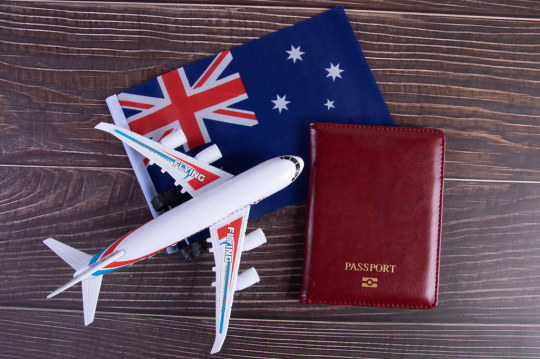#Subclass 491
Explore tagged Tumblr posts
Text
Everything You Need to Know About Subclass 491 Visa

The Subclass 491 Skilled Work Regional (Provisional) Visa offers skilled professionals the opportunity to live, work, and study in designated regional areas of Australia for up to five years. It provides a pathway to permanent residency through the Subclass 191 visa after meeting eligibility criteria.
0 notes
Text

Start Your Journey to Permanent Residency with Subclass 491
Are you dreaming of living and working in regional Australia? The Skilled Work Regional Visa Subclass 491 offers a pathway to achieve that goal. This temporary visa is designed for skilled workers nominated by a state or territory government or sponsored by an eligible family member in a designated regional area. With the Subclass 491 visa, you can live, work, and study in regional Australia for up to five years, gaining access to exciting opportunities and a vibrant lifestyle. Our migration agent in Perth can guide you through the application process, ensuring a smooth journey toward your Australian dream.
0 notes
Text
Australian Immigration Without an Employment Offer
Victoria Province in Australia has introduced two new visa pathways that allow people to work, study, and settle permanently in Australia without requiring a prior job offer. These pathways, known as Visa 190 and Visa 491, provide a route to permanent residency and are creating excitement among those interested in Australian immigration.
Australian Subclass 190 Visa

The Visa 190 is a key component of Australian immigration, designed for skilled professionals who have been nominated by a state or territory government. This visa does not necessitate a job offer, offering an exceptional opportunity to live and work in Australia permanently. It also potentially leads to Australian citizenship, appealing greatly to those planning to establish a lasting home in Australia.
Subclass 491 Visa (Skilled Regional Visa)
The Skilled Work Regional (Provisional) visa, known as Visa 491, is part of Australian immigration and offers skilled workers the opportunity to live, work, and study in designated regional areas for up to five years, with a path to permanent residency. To be eligible for this visa, candidates must choose an approved region and commit to living and working there for three years. After this period, they have the option to move and work anywhere in Australia. Permanent residency can be applied for within two to three years after obtaining Visa 491.
The main difference between Visa 190 and Visa 491 is the flexibility they provide in terms of choosing where to live and work in Australia.
Importance of Expression of Interest
Visa 190 and Visa 491 offer the chance to move to any region within Australia without requiring a job offer, positioning them as attractive options for many prospective migrants. Furthermore, Victoria Province has implemented the Expression of Interest (EOI) system, showcasing its willingness to receive applications and expressions of interest from those looking to immigrate to this area.T eddgfghjnkml,;
How Can You Qualify for Australian Immigration?
To be eligible for these visa options, individuals need to fulfill a set of requirements:
Residency: Applicants must be willing to live in Victoria Province.
Registration: They must complete a Registration of Interest (ROI).
Age Limit: Candidates should be younger than 45 years old.
Language Skills: Proficiency in English is required.
Skills Assessment: A valid Skills Assessment from a relevant authority must be presented.
Occupational Experience: Experience must be in a profession that is included on the visa's eligible occupation list.
Points Test: Applicants must score at least 65 points on the Australian Government's points test, which is part of the Expression of Interest (EOI) process in SkillSelect.
What is the Application Process for the Visa?

The visa application process entails a series of structured steps:
Expression of Interest (EOI): Begin by submitting an Expression of Interest through SkillSelect, which is managed by the Australian Government’s Department of Home Affairs. This is where you detail your qualifications, work experience, and other personal information.
Registration of Interest (ROI): After you receive an EOI number from SkillSelect, you must apply for a Victorian nomination. This involves completing a Registration of Interest on the Live in Melbourne portal.
Nomination Application: If you are invited following your ROI submission, you'll need to complete a full nomination application within the Live in Melbourne portal.
Visa Application: Once your nomination application is approved, you can proceed to apply for your chosen visa (either Visa 190 or Visa 491) through the Australian Government’s Department of Home Affairs.
Evaluation Process for Registration of Interest:
When assessing Registrations of Interest (ROIs), several factors are considered to determine your suitability for nomination:
Age: Preference is often given to candidates who are likely to have a longer working life.
English Proficiency: Your ability to communicate effectively in English is crucial.
Work Experience: Years of experience in your nominated occupation can significantly impact your application.
Educational Qualifications: Your academic records and relevant qualifications are assessed.
Partner’s Skills: If applicable, the skills and qualifications of your partner may also be taken into account.
Salary: For candidates already working in Australia, the salary can indicate the demand and level of skill in their current role.
Each of these components plays a crucial role in determining whether you will be invited to apply for a visa, as they collectively form a profile of your potential to contribute to the region’s needs and economic growth.
Importantly, particular attention is given to certain job sectors when evaluating applications, especially for the Visa 491. These sectors include healthcare, social services, information and communication technology (ICT), education, advanced manufacturing, infrastructure, renewable energy, as well as hospitality and tourism. These industries are prioritized because they are critical to the regional development and economic growth of the areas designated under the Visa 491 program. Applicants with skills and experience in these fields are highly valued and may have a better chance of receiving an invitation to apply for a visa.
Securing Skill Assessment
Securing a skills assessment is a vital component of the visa application process. In Australia, experienced professionals within your industry will instruct you on which documents are necessary for submission. After you have gathered and submitted these documents, they will assess if your skills and qualifications match the standards required for your chosen occupation in Australia. This assessment will result in either a positive or negative outcome. Designated skills assessment organizations are tasked with verifying that your qualifications and professional abilities conform to the specific occupational standards needed for employment. These organizations play an important role in determining your eligibility to apply under the skilled migration visa categories.
#Australian immigration#EOI#ROI#Victoria#Australian govt#subclass 190#subclass 491#permanent residency
0 notes
Text

Join us in the journey of a lifetime with your family! Experience the beauty of New South Wales and South Australia as they welcome you with open arms through the subclass 491 visa and 190 visa programs. Start a new chapter together in these vibrant and diverse regions.
0 notes
Text

To know about Australia PR visa processing time, you first need to understand the types of visa categories Australia offers to PR visa aspirants.
0 notes
Photo

The Skilled Work Regional (Subclass 491) Visa will enable all skilled workers and their families to live, pursue education and work in designated regional areas of Australia. This 491 visa is valid for a tenure of 5 years.
Read More >> https://edgeoverweb.com/business/complete-guide-on-skilled-work-regional-subclass-491-visa/
0 notes
Text

0 notes
Text
Exploring the Subclass 491 Visa: Your Path to Australian Residency

Australia, known for its stunning landscapes, diverse culture, and strong economy, has long been a popular destination for immigrants seeking a better life. If you're considering making the Land Down Under your new home, the Subclass 491 Visa is a great choice. In this article, we'll explore what the Subclass 491 Visa is, its key features, and how you can apply for it.
What is the Subclass 491 Visa?
The Subclass 491 Visa, also known as the Skilled Work Regional (Provisional) Visa, is designed for individuals who want to live and work in regional areas of Australia. This visa allows you to stay in the country for up to five years and paves the way for permanent residency.
Key Features of the Subclass 491 Visa:
1. Regional Residency:
The Subclass 491 Visa is specifically intended for those who wish to settle in regional areas of Australia. Regional areas are defined as locations outside major cities like Sydney, Melbourne, and Brisbane. These regions offer unique opportunities and a different pace of life compared to city living.
2. Sponsorship or Nomination:
To apply for this visa, you need either a state or territory government nomination or an eligible family member's sponsorship. This means that you must have a connection to the region that's willing to support your application.
3. Occupation List:
Applicants must select an occupation from the relevant Skilled Occupation List (SOL) or the Regional Occupation List (ROL). Your chosen occupation must align with your skills and qualifications.
4. Points Test:
To be eligible, you must score a minimum number of points on the points test. Points are awarded based on factors like age, language proficiency, work experience, and educational qualifications.
5. Provisional Residency:
The Subclass 491 Visa is a provisional visa, which means that it grants temporary residency for up to five years. During this period, you can live and work in your chosen regional area.
6. Pathway to Permanent Residency:
One of the most significant benefits of this visa is that it offers a pathway to permanent residency through the Subclass 191 Visa. After living and working in a regional area for at least three years and meeting other requirements, you can apply for permanent residency.
7. Health and Character Checks:
All visa applicants must undergo health and character assessments to ensure they meet Australia's health and character requirements.
How to Apply for the Subclass 491 Visa:

Check Eligibility: Before applying, make sure you meet the eligibility criteria, including age, language proficiency, occupation, and skills assessment.
Choose a Regional Area: Select a regional area where you intend to live and work. Remember that this choice is vital for your application.
Nomination or Sponsorship: Secure either a state or territory government nomination or sponsorship from an eligible family member living in a designated regional area.
Skills Assessment: Obtain a positive skills assessment for your chosen occupation. This assessment verifies that your qualifications and experience meet Australian standards.
Submit an Expression of Interest (EOI): Lodge an EOI through the Department of Home Affairs' SkillSelect system. Provide details about your skills, qualifications, and other relevant information.
Wait for an Invitation: If your EOI is successful, you will receive an invitation to apply for the Subclass 491 Visa.
Apply for the Visa: Complete the visa application, including all required documents and information. Pay the application fee.
Health and Character Checks: Undergo the necessary health and character assessments as part of the application process.
Wait for a Decision: After submitting your application, you'll need to wait for a decision from the Department of Home Affairs.
Prepare for Arrival: If your application is successful, you'll be granted a Subclass 491 Visa, and you can start planning your move to Australia.
Final Thoughts:
The Subclass 491 Visa is a fantastic opportunity for individuals looking to build a life in Australia's regional areas. It provides temporary residency and, more importantly, a pathway to permanent residency, making it a popular choice for those seeking long-term settlement in this beautiful country. Remember that the application process can be complex, so it's essential to seek professional guidance if needed. If you meet the requirements and are willing to embrace the charms of regional Australia, the Subclass 491 Visa may be your ticket to a brighter future down under.
0 notes
Text
https://provinceimmigration.com/australia-immigration/skilled-work-regional-provisional-visa-subclass-491/
0 notes
Text

How Australia Prioritizes Skilled Visa Applications
Australia is a desirable destination for many skilled migrants who want to contribute to its economy and society. To manage its skilled migration program effectively, Australia has established a system of processing priorities for different types of skilled visas.
#Australia Skilled Migration#Subclass 190 Visa#Subclass 491 Australia#skilled migration program#migrate to Australia
0 notes
Text
ANZSCO 233215 Transport Engineer
Transport engineers increase the efficency of infrastructure and the affordability of moving people and goods. The planning and design of the transportation system are done by transport engineers. There can be a need for registration or licensing.
A Transport Engineer (ANZSCO 233215) is responsible for the design, construction, organization, and supervision of transportation infrastructure, including roads, railways, airports, and public transit systems, ensuring they operate safely, cost-effectively, and sustainably. Patterns of traffic are studied alongside the infrastructure’s capabilities and connectivity to come up with ways to alleviate traffic build up. A transport engineer integrates new technologies with the existing ones to improve mobility while also considering the impacts these enhancements have on the environment and economy. Transport systems must be properly integrated into infrastructure development projects, which means these engineers must work with urban design planners, legislators, and other engineers. Their work often seeks to improve mobility and reduce congestion in both urban and rural areas.
On the Occupation Lists
489 (S/T) Occupations List
482 TSS Visa Medium Term List
407 Training visa occupations List
482 TSS Visa Regional Occupation List
189 Skilled Independent and Family Sponsored 489 Occupations List and 485 Graduate Work Stream
190 State/Territory Sponsored
186 ENS Visa Occupations List
187 RSMS Visa Occupations List
491 — Skilled Work Regional (provisional) visa (subclass 491) Occupation List
494 — Skilled Employer-Sponsored Regional (provisional) (subclass 494) — Employer-sponsored stream

Unit Group 2332: Transport Engineer Professionals
Transport engineering professionals assess how soil and rock will behave under pressure from planned structures and design suitable foundations. They also focus on designing and organizing transportation systems, ensuring efficiency and safety. In addition, civil engineering professionals analyze the durability of materials and the statistical properties of various structures. Transport engineers are also responsible for estimating and monitoring project costs to ensure budget control and effective implementation.
Engineers dealing with engineering structures examine the soil and rock behavior of planned structures under pressure and, thus, provide safe and stable foundations. They study the construction materials as well as the various structures and their statistics. Moreover, transport engineering entails planning and organizing transportation systems with regard to the safety, efficiency, and sustainability of the systems. They are also responsible for the estimating and monitoring the project costs for high value and low cost solutions.
Task Included
To design the physical infrastructure of transportation systems.
To consider population growth and evolving needs when analyzing current and future travel flow patterns.
Transport engineers predict the expense of creating thorough cost plans.
To review architectural drawings and specifications to estimate total costs, serving as a tool for budgetary control.
To coordinate site activity, transport engineers create intricate schedules.
Transport engineers plan and manage to build site labor as well as the supply of tools, machinery, and supplies.
Construction techniques, materials, and quality requirements for transportation infrastructure are decided by transport engineers.
Transport engineers create and understand building processes, plans, drawings, and requirements.
Transportation engineers are familiar with both static and dynamic load analyses.
Structures that do not collapse, flex, twist, or shake unfavorably are designed by transport engineers.
Occupation in this Group
233212 Geotechnical Engineer
233215 Transport Engineer
233214 Structural Engineer
233213 Quantity Surveyor
233211 Structural Engineer
Why is CDR for Australia the best service out there?
We understand the customer’s needs and work diligently to satisfy them, creating their application, CV, RPL reports, and CDR reports with accuracy. CDR for Australia is the best option for CDR services since our group of specialist CDR writers is familiar with the unique needs of ANZSCO Codes, and we can assist engineers on how to prepare an outstanding report that adheres to Engineers Australia’s guidelines. We specialize in providing 100% unique MSA content that strictly adheres to MSA guidelines.
Our staff is highly qualified and experienced in the technical aspects of generating a CDR report, ensuring that it meets Engineers Australia’s stringent standards.
Contact us if you want assistance with CDR.
For more details
Call or WhatsApp : +61 482 081 740
Email: [email protected]
Visit our website: CDR for Australia
#cdr#cdr report#skillassessment#cdr australia#australia engineer#engineer australia#PR visa#visa program#transport engineer
0 notes
Text
Everything You Need to Know About Subclass 491 Visa

The Subclass 491 Skilled Work Regional (Provisional) Visa is a temporary visa designed to encourage skilled professionals to live and work in regional areas of Australia. It provides a pathway to permanent residency and helps address skill shortages in less populated regions.
Key Features of the Subclass 491 Visa
Valid for up to 5 years.
Requires living and working in a designated regional area.
Offers a pathway to permanent residency through the Subclass 191 visa after meeting specific criteria.
Ability to include eligible family members in your application.
Eligibility Requirements
To apply for a Subclass 491 Visa, you must:
Be nominated by an Australian state or territory government or sponsored by an eligible family member living in a designated regional area.
Have a skilled occupation listed on Australia’s relevant occupation lists.
Obtain a positive skills assessment for your occupation.
Meet the required points score for the visa.
Be under 45 years of age at the time of invitation.
Demonstrate English language proficiency.
Meet health and character requirements.
Benefits of the Subclass 491 Visa
Live, work, and study in regional Australia for up to 5 years.
Enjoy access to healthcare and other public services.
Gain valuable work experience in regional areas.
Fast-track your eligibility for permanent residency with the right criteria.
Application Process
Check Eligibility: Ensure your occupation is on the relevant list and you meet the other requirements.
Expression of Interest (EOI): Submit an EOI through the SkillSelect system.
Nomination/Sponsorship: Obtain a nomination from a state or territory government or sponsorship from an eligible family member.
Invitation to Apply: Receive an invitation to apply for the Subclass 491 Visa.
Submit Visa Application: Lodge your application online with all required documentation.
Tips for a Successful Application
Ensure your EOI is accurate and complete.
Research regional areas to understand the job market and lifestyle.
Work closely with your state or territory government for nomination support.
Seek professional advice if needed to improve your points score or application quality.
Conclusion
The Subclass 491 Visa is an excellent opportunity for skilled professionals to build a future in regional Australia while enjoying a pathway to permanent residency. By contributing to regional economies, you not only help address skill shortages but also secure a promising future for yourself and your family.
For expert assistance with your application and nomination process, consider Immigration consulting an experienced immigration professional to maximize your chances of success. Start your journey to Australia’s vibrant regional communities today!
0 notes
Text

Secure Your Future in Regional Australia with the visa subclass 491
Are you aiming to live and work in regional Australia? The 491 Skilled Work Regional (Provisional) Visa could be your ideal pathway! This visa allows skilled workers and their families to live, work, and study in designated regional areas for up to five years, with a pathway to permanent residency. To qualify, applicants must meet certain requirements, including nomination by a state or territory government, relevant work experience, and a positive skills assessment. Our Migration Agent in Perth can guide you through every requirement, helping you secure your future in Australia. Embrace new opportunities in regional Australia today!
0 notes
Text
How to Migrate to Australia Without a Job Offer
In a significant development for prospective immigrants, Victoria Province in Australia has launched two visa pathways that enable individuals to work, study, and live permanently in Australia without needing a job offer.

It opens the door to permanent residency through the Visa 190 and Visa 491 routes, and it is already generating considerable buzz among potential immigrants.
Visa 190: The Path to Permanent Residency
The Visa 190 is a permanent Australian visa for skilled migrants nominated by an Australian state or territory government. It eliminates the requirement for a job offer, offering a golden chance to live and work in Australia indefinitely. Notably, this visa could pave the way for Australian citizenship in the future, making it an enticing option for those looking to make Australia their new home.
Visa 491: The Regional Opportunity
The Skilled Work Regional (Provisional) visa, also known as Visa 491, offers skilled immigrants the chance to reside, study, and work in specific regional areas for a period of five years, with the potential for permanent residency. To qualify for this pathway, individuals must select an eligible province or state and reside and work there for three years. Following this period, they gain the flexibility to relocate and work in any region of Australia. Applicants may apply for permanent residency within two to three years of acquiring the Visa 491.
The primary distinction between Visa 190 and Visa 491 lies in the level of freedom they offer concerning the choice of location for living and working within Australia.
Expression of Interest: A Pivotal Step
Both Visa 190 and Visa 491 open doors to relocate to any province within Australia without the need for a job offer, making them a promising option for many. Additionally, Victoria Province has introduced the Expression of Interest (EOI) application process, indicating its readiness to accept applications or expressions of interest from individuals aspiring to immigrate to this particular province.
Eligibility Criteria and Application Process

The eligibility criteria for these visa pathways include:
Willingness to live in Victoria province Selection of a Registration of Interest (ROI) Age under 45 Competency in English Possession of a valid Skills Assessment Experience in an occupation listed for this visa Scoring at least 65 points on the Australian Government’s points test for your Expression of Interest (EOI) in SkillSelect The visa application process involves four steps:
Submit an Expression of Interest (EOI) to the Australian Government’s Department of Home Affairs through SkillSelect. Upon receiving your EOI number from SkillSelect, apply for a Victorian nomination by completing a Registration of Interest (ROI) on the Live in Melbourne portal. If you receive an invitation, proceed to complete a nomination application within the Live in Melbourne portal. Upon approval of your nomination application, you can then submit a visa application for your chosen visa to the Australian Government’s Department of Home Affairs. Evaluation Process for Registration of Interest
When assessing Registration of Interests (ROIs), various factors come into play, including age, English proficiency, years of experience in the nominated occupation, educational qualifications, skills of your partner (if applicable), and salary (for onshore candidates).
Notably, specific emphasis is placed on jobs in healthcare, social services, information communication technology (ICT), teaching roles, advanced manufacturing, infrastructure, renewable energy, and hospitality and tourism (especially for the Visa 491).
Skills Assessment: A Critical Step
Obtaining a skills assessment is crucial. Professionals experienced in your field in Australia will guide you on the specific documents to submit. Once these documents are collected, they will evaluate whether your skills and qualifications align with the requirements in Australia, ultimately providing a positive or negative outcome.
Skills assessments are provided by designated skills assessment organizations responsible for verifying that your skills meet the specific standards for employment in your chosen occupation.
Source: BUSINESS DAY
0 notes
Text

The Australian Subclass 190 visa pathway offers a compelling opportunity for skilled individuals seeking to immigrate to Australia as a Marketing Specialist. This visa category is designed to address the country's specific skill shortages and ensure that qualified professionals contribute to Australia's economy and society. Here's a brief overview of the key requirements for aspiring Marketing Specialists considering this immigration route:
Relevant Degree: To be eligible for the Subclass 190 visa as a Marketing Specialist, you must hold a relevant degree in marketing or a related field. This ensures that you possess the necessary educational foundation to excel in your chosen profession.
Relevant Work Experience: Applicants are typically required to have at least three years of relevant work experience as a Marketing Specialist. This experience showcases your expertise in the field and is crucial in demonstrating your value to potential employers in Australia.
Language Proficiency (IELTS): Adequate English language proficiency is essential for successful immigration. Applicants often need to achieve a specified score on the International English Language Testing System (IELTS) to demonstrate their ability to communicate effectively in English.
Age Limit: The Subclass 190 visa typically imposes an age limit, which is often set at 45 years. Meeting this age requirement is essential to qualify for this immigration pathway.
Once these requirements are met, aspiring Marketing Specialists can express their interest in immigrating to Australia through the SkillSelect system. This process involves submitting an Expression of Interest (EOI) and waiting for an invitation from an Australian state or territory government to apply for the Subclass 190 visa. Successful applicants will enjoy the benefits of living and working in Australia as skilled professionals while contributing to the country's vibrant marketing industry.
Overall, the Subclass 190 visa for Marketing Specialists represents an attractive immigration opportunity for individuals who meet the specified criteria, offering a chance to build a promising career and a fulfilling life in the land Down Under.
0 notes
Text
issuu
The skilled nominated 190 visa allows skilled foreign nationals to live, work, and study in Australia as permanent residents. Under this visa stream, nominated applicants can secure permanent residency status in Australia and also sponsor eligible family members for the same.
#skilled nominated 190 visa#Skilled Nominated 491 Visa#189 subclass visa Australia#Australia Skilled Migration
0 notes